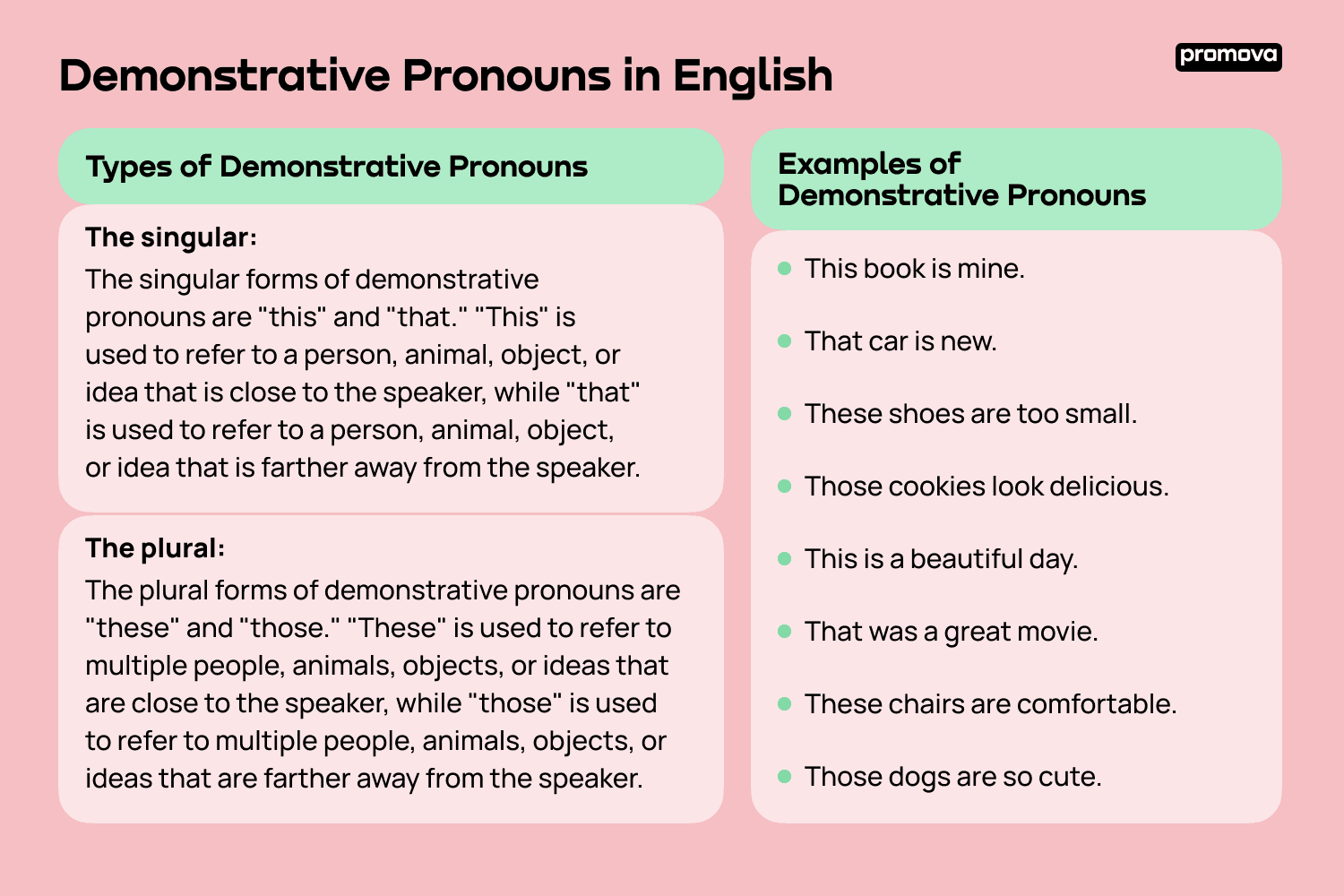Demonstrative Pronouns in English
Contents
In English, there are four primary demonstrative pronouns, and understanding them is fundamental to mastering the language. In this reference, we’ll provide a comprehensive overview of demonstrative pronouns, including their types, examples, sentences, and common mistakes.
What are Demonstrative Pronouns?
Demonstrative pronouns are words that are used to refer to or point to a particular person, place, or thing. They can be used to indicate the relative distance of the object being referred to, whether it is close or far away. The four primary demonstrative pronouns in English are "this," "that," "these," and "those." They are used to point out people, animals, objects, or ideas.
For example, if you were to say "This is a pencil," you would be indicating that the pencil you are referring to is close to you. However, if you were to say "That is a pencil," you would be indicating that the pencil is farther away from you.
Demonstrative pronouns are also used to replace a noun in a sentence. For example, if you were to say "This pencil is sharp," you would be indicating that the pencil you are referring to is close to you. In this case, the demonstrative pronoun "this" is replacing the noun "pencil."

Types of Demonstrative Pronouns
There are two types of demonstrative pronouns in English: singular and plural forms.
The singular forms of demonstrative pronouns are "this" and "that." "This" is used to refer to a person, animal, object, or idea that is close to the speaker, while "that" is used to refer to a person, animal, object, or idea that is farther away from the speaker.
The plural forms of demonstrative pronouns are "these" and "those." "These" is used to refer to multiple people, animals, objects, or ideas that are close to the speaker, while "those" is used to refer to multiple people, animals, objects, or ideas that are farther away from the speaker.
Examples of Demonstrative Pronouns
Here are some examples of demonstrative pronouns:
- This book is mine.
- That car is new.
- These shoes are too small.
- Those cookies look delicious.
- This is a beautiful day.
- That was a great movie.
- These chairs are comfortable.
- Those dogs are so cute.
Demonstrative Pronoun Sentences
Demonstrative pronouns can be used in a variety of sentences to refer to people, animals, objects, or ideas. Here are some examples of demonstrative pronoun sentences:
- This pencil is sharp.
- That phone is expensive.
- These chairs are comfortable.
- Those flowers are beautiful.
- This food is delicious.
- That tree is tall.
- These books are interesting.
- Those clouds look like cotton candy.
3
How to Use Demonstrative Pronouns
It’s important to understand how to use demonstrative pronouns correctly in order to effectively communicate in English. Here are some tips for using demonstrative pronouns:
- Use the singular forms “this” and “that” to refer to a single person, animal, object, or idea.
- Use the plural forms “these” and “those” to refer to multiple people, animals, objects, or ideas.
- When using demonstrative pronouns, the speaker should always be aware of the relative distance of the object being referred to.
- Demonstrative pronouns should always be used to replace a noun in a sentence.
- Demonstrative pronouns should always agree with the noun they are replacing in terms of gender and number.
List of Demonstrative Pronouns
As you've already learned, the list of demonstratives is quite short:
- This (singular)
- That (singular)
- These (plural)
- Those (plural)
Summary
Demonstrative pronouns are words used to point out or refer to specific persons, places, or things. There are just four of them and you can quickly understand how to apply them in sentences with the help of this reference. We hope this was helpful in your journey to mastering English demonstrative pronouns!



Comments